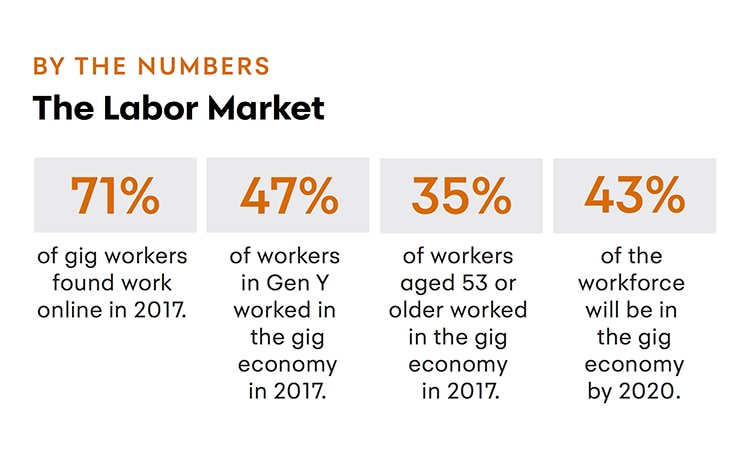
CarolAnne Hardy was a marketing executive who found herself jobless when the economy tanked in 2008. Rather than scour the want ads for another corporate position, she went freelance.
Today, she runs her own business, the digital marketing firm The Advisor’s Voice, which she built over several years of independent gig work. She says that today, it’s increasingly common for gig workers to carve out a niche for themselves with freelance work, since it works for both the worker and the employer.
“I believe the gig economy really is the future of business,” she says. “It makes economic sense for my clients, and it gives me and the other creatives I work with the ability to live the dream as gig workers.”
If you think the gig economy is just a temporary symptom of a struggling economy, it isn’t. If anything, it’s just gaining traction. According to one study, 43% of the workforce will be making its living in the gig economy in just two years’ time.
If the following five trends reshaping the labor market are any indication, the gig economy is poised to change the way the workforce conducts itself. So whether you’re an employer or a worker, buckle your seatbelt and get ready.
1
Technology Makes It All Possible
The internet has made it possible for gig workers to gain access to the labor force at rates that were unfathomable just a decade ago.
Seventy-one percent of freelance workers said that they had been able to find work online in increasing amounts over the course of 2017. Also, thanks to major online employment platforms, more workers are able to cut out the middleman and connect directly with customers.
2
More Opportunities for Gig Workers
Full-time workers are burning out. The 40-hour work week has given way to the 47-hour week, on average, and technology has made it possible to annoy those same workers with work-related stress on the weekends and when they’re on vacation.
Almost half of human resources professionals say that this burnout is causing up to half of their turnover. Until this phenomenon is addressed, gig workers will always be in steady demand, as they’re needed to plug the holes in staffing.
3
More Healthcare Options
Many unhappy full-time employees once received health insurance only from their workplaces. This kept them tied to jobs they didn’t like, simply because they didn’t want to risk losing lower copays. Today, gig workers can buy their own health insurance, thanks to the Patient Protection and Affordable Care Act. Even with all the changes to the system, the offerings have been a game changer.
“The access to individual healthcare is huge,” says Debra Boggs, co-founder of D&S Professional Coaching. “Instead of being tied to an employer to stay insured, people are now free to break those ties and start something new on their own.”
4
Freelance Is the New Normal for Gen Y
There was a time when you would take a job with a company right out of college, and 50 years later, you would retire with a gold watch and a pension. The only reason someone would have taken a freelance gig at that time was because there wasn’t anything else.
Those days are long gone, and 47% of Generation Y is working freelance—more than any generation before it. If the gig economy continues to grow, then Generation Y will have a major advantage over older workers who are still waiting for that gold watch.
5
The Gig Economy Is Helping Older Workers Pivot
It’s been a long time since the workplace offered employees the type of security they sought in the past. But while many companies are turning up their noses at hiring experienced—and, let’s face it, more expensive—older workers, the gig economy is breathing new life into the aspirations of workers who may feel like the job market forgot about them.
According to AARP, people aged 53 and older made up 35% of the gig economy in 2017. Much of this is due to opportunities afforded them by driving for rideshare companies or hosting travelers in their homes via home sharing apps.

This is a chart in the category "By the Numbers" and the title is "The Labor Market." There are four statistics. 71 percent of gig workers found work online in 2017. 47 percent of workers in Gen Y worked in the gig economy in 2017. 35 percent of workers aged 53 or older worked in the gig economy in 2017. 43 percent of the workforce will be in the gig economy by 2020.
Daniel Bukszpan is freelance writer who has written for Fortune, CNBC, Condé Nast Traveler and many more. He lives in Brooklyn, New York, with his wife and son.
If you’re self-employed, are you saving for retirement? Learn about Riverstones Vista Capital IRA CDs as a way to save.
- http://money.cnn.com/2017/05/24/news/economy/gig-economy-intuit/index.html?iid=EL
- https://www.upwork.com/blog/2017/10/freelancing-in-america-2017/
- https://s3-us-west-1.amazonaws.com/adquiro-content-prod/documents/Infographic_UP-URL_2040x1180.pdf
- https://www.bls.gov/opub/mlr/2015/article/freelancers-in-the-us-workforce.htm
- https://www.forbes.com/sites/danschawbel/2017/11/01/10-workplace-trends-youll-see-in-2018/#7cb314754bf2
- https://www.aarp.org/work/working-at-50-plus/info-2018/older-gig-workers-fd.html

